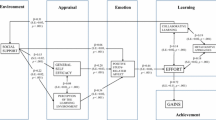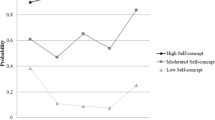Abstract
The present study investigates the characteristics which differentiate between first-year university students who maintain their high school averages (Maintainers: n = 165) and those whose averages decrease at least one letter grade (Decliners: n = 435). The 600 students entered first year at one of six Canadian Universities, which varied in size and ethnic diversity. Data were collected in August, prior to the start of school, and in November of first year. Multivariate analyses indicated significant group differences between Maintainers and Decliners on familial variables (gender, fathers’ education level, but not family income, parental reciprocity, parental support or immigrant/generational status), psychological well-being (perceived stress in August and November, and November depression, self-esteem and health), and university adjustment (university plans, transition perception, time management and university adaptation). The current study addresses a gap in the existing academic achievement literature, while providing practical information to students, parents, and educators involved in the transition to university.
Similar content being viewed by others
Notes
Regarding gender t(1,1073) = −4.232, p < .000, participants included in the sample consisted of a lower proportion of male students (32.6% vs. 45.3%) and a higher proportion of female students (67.4% vs. 54.7%). The difference in high school average t(1,975) = −3.164, p = .002, indicated the present sample achieved a higher high school average (M = 84.24 vs. 83.00). Finally the present sample had a higher score on the November 2004 SACQ attachment subscale scores (1,798) = −2.902, p = .004, than the excluded participants (M = 99.47 vs. M = 94.04).
References
Babyak, M. A. (2004). What you see may not be what you get: A brief, nontechnical introduction to overfitting in regression-type models. Psychosomatic Medicine, 66(3), 411–421.
Baker, S. R. (2003). A prospective longitudinal investigation of social problem-solving appraisal on adjustment to university, stress, health, and academic motivation and performance. Personality and Individual Differences, 35, 569–591.
Baker, R. W., McNeil, O. V., & Siryk, B. (1985). Expectation and reality in freshman adjustment to college. Journal of Counseling Psychology, 32, 94–103.
Baker, R. W., & Siryk, B. (1984). Measuring adjustment to college. Journal of Counseling Psychology, 31, 179–189.
Baker, R. W., & Siryk, B. (1989). Student adaptation to college questionnaire (SACQ). Los Angeles, CA: Western Psychological Services.
Baron, J., & Norman, M. F. (1992). SATs, achievement tests, and high-school class rank as predictors of college performance. Educational and Psychological Measurement, 52(4), 1047–1055.
Baumeister, R. F., Campbell, J. D., Kruegger, J. I., & Vohs, K. D. (2003). Does high selfesteem cause better performance, interpersonal success, happiness, or healthier lifestyles? Psychological Science in the Public Interest, 4(1), 1–44.
Birnie-Lefcovitch, S. J. (1998). Adaptation during the transition from high school to university: An examination of selected person, environment and transition perception variables. ProQuest Information & Learning. Dissertation Abstracts International Section A: Humanities and Social Sciences, 58(9-A), 3435.
Birnie-Lefcovitch, S. (2000). Student perceptions of the transition from high school to university: Implications for preventative programming. Journal of the First-Year Experience, 12, 61–88.
Britton, B. K., & Tesser, A. (1991). Effects of time-management practices on college grades. Journal of Educational Psychology, 83, 405–410.
Clifton, R. A., Perry, R. P., Stubbs, C. A., & Roberts, L. W. (2004). Faculty environments, psychosocial dispositions, and the academic achievement of college students. Research in Higher Education, 45, 801–828.
Clifton, R. A., Perry, R. P., Roberts, L. W., & Peter, T. (2007). Gender, psychosocial dispositions, and the academic achievement of college students. Research in Higher Education, 49, 684–703.
Cohen, S., Kamarck, T., & Mermelstein, R. (1983). A global measure of perceived stress. Journal of Health and Social Behavior, 24, 385–396.
Cutrona, C. E., Cole, V., Colangelo, N., Assouline, S. G., & Russell, D. W. (1994). Perceived parental social support and academic achievement: An attachment theory perspective. Journal of Personality and Social Psychology, 66, 369–378.
Demo, D. H., & Parker, K. D. (1988). Academic achievement and self-esteem among black and white college students. The Journal of Social Psychology, 127, 345–355.
Dispenzier, A. (1971). College performance of disadvantaged students as a function of ability and personality. Journal of Counseling Psychology, 18, 298–305.
Elder, G. H. (1995). The life course paradigm: Social change and individual development. In P. Moen, G. H. Elder Jr., & K. Lüscher (Eds.), Examining lives in context: Perspectives on the ecology of human development (pp. 101–139). Washington, DC: American Psychological Association.
Elias, S. M., & MacDonald, S. (2007). Using past performance, proxy efficacy, and academic self-efficacy to predict college performance. Journal of Applied Social Psychology, 37, 2518–2531.
Etcheverry, E., Clifton, R. A., & Roberts, L. W. (2001). Social capital and educational attainment: A study of undergraduates in a faculty of education. The Alberta Journal of Educational Research, 47, 24–39.
Fazio, N. M., & Palm, L. J. (1998). Attributional style, depression, and grade point averages of college students. Psychological Reports, 83, 159–162.
Garden, A. (1991). Relationship between burnout and performance. Psychological Reports, 68, 963–977.
Goldman, C. S., & Wong, E. H. (1997). Stress and the college student. Education, 117, 604–611.
Hooper, H. H. (1968). Predictors of college success. Research in Education, 3, 12–16.
Kerr, S., Johnson, V. K., Gans, S. E., & Krumrine, J. (2004). Predicting adjustment during the transition to college: Alexithymia, perceived stress, and psychological symptoms. Journal of College Student Development, 45(6), 593–611.
Khawaja, N. G., & Bryden, K. J. (2006). The development and psychometric investigation of the university student depression inventory. Journal of Affective Disorders, 96(1–2), 21–29.
Lyubomirsky, S., Kasri, F., & Zehm, K. (2003). Dysphoric rumination impairs concentration on academic tasks. Cognitive Therapy Research, 27, 309–330.
Matt, G. E., Pechersky, B., & Cervantes, C. (1991). High school study habits and early college achievement. Psychological Reports, 69, 91–96.
McCausland, D. F., & Stewart, N. E. (1974). Academic aptitude, study skills, and college GPA. Journal of Educational Research, 67, 354–357.
McDonald, R. T., & Gawkoski, R. S. (1979). Predictive value of SAT scores and high school achievement for success in a college honors program. Educational and Psychological Measurement, 39, 411–414.
McKenzie, K., & Schweitzer, R. (2001). Who succeeded at university? Factors predicting academic performance in first year Australian university students. Higher Education Research & Development, 20, 21–33.
Midgett, J., Ryan, B. A., Adams, G. R., & Corville-Smith, J. (2002). Complicating achievement and self-esteem: Considering the joint effects of child characteristics and parent–child interactions. Contemporary Educational Psychology, 27(1), 132–143.
Neely, R. (1977). Discriminant analysis for prediction of college graduation. Educational and Psychological Measurement, 37, 965–970.
Peduzzi, P., Concato, J., Kemper, E., Holford, T. R., & Feinstein, A. R. (1996). A simulation study of the number of events per variable in logistic regression analysis. Journal of Clinical Epidemiology, 49, 1373–1379.
Radloff, L. S. (1977). Centre for epidemiologic studies depression scale. In J. P. Robinson, P. R. Shaver, & L. S. Wrightsman (Eds.), Measures of personality and social psychological attitudes (pp. 212–215). Toronto: Academic Press.
Rosenberg, M. (1965). Society and the adolescent self-image. Princeton, NJ: Princeton University Press. Scale reprinted in: Blascovich, J. & Tomaka, J. (1991). Measures of self-esteem. In J. P. Robinson, P. R. Shaver, & L. S. Wrightsman (Eds.), Measures of personality and social psychological attitudes. Toronto: Academic Press.
Rosenthal, B. S., & Schreiner, A. C. (2000). Prevalence of psychological symptoms among undergraduate students in an ethnically diverse urban public college. Journal of American College Health, 49(1), 12–18.
Scheier, M. F., & Carver, C. S. (1987). Disposition optimism and physical well-being: The influence of generalized outcome expectancies on health. Journal of Personality, 55, 183–210.
Statistics Canada. (2002). At a crossroads: First results for the 18–20-year-old cohort of the youth in transition survey. Retrieved December 5, 2008, from http://www.statcan.gc.ca/pub/81-591-x/81-591-x2000001-eng.pdf.
Statistics Canada. (2008). Postsecondary education—Participation and dropping out: Differences across university, college and other types of postsecondary institutions. Retrieved December 5, 2008, from http://www.statcan.gc.ca/pub/81-595-m/81-595-m2008070-eng.pdf.
Steinberg, L., Elmen, J. D., & Mounts, N. S. (1989). Authoritative parenting, psychosocial maturity, and academic success among adolescents. Child Development, 60, 1424–1436.
Steinberg, L., Lamborn, S. D., Dornbusch, S. M., & Darling, N. (1992). Impact of parenting practices on adolescent achievement: Authoritative parenting, school involvement, and encouragement to succeed. Child Development, 63, 1266–1281.
Stupnisky, R. H., Renaud, R. D., Perry, R. P., Ruthig, J. C., Haynes, T. L., & Clifton, R. A. (2007). Comparing self-esteem and perceived control as predictors of first-year college students’ academic achievement. Social Psychology of Education, 10, 303–330.
Tinto, V. (1975). Dropouts from higher education: A theoretical synthesis of recent research. Review of Educational Research, 45, 89–125.
Trockel, M. T., Barnes, M. D., & Egget, D. L. (2000). Health-related variables and academic performance among first-year college students: Implication for sleep and other behaviors. Journal of American College Health, 49, 125–131.
Turbow, P. Y. (1985). The relationship of exercise to academic achievement and sense of well-being among college students. ProQuest Information & Learning. Retrieved December 4, 2008, from www.csa.com.
Vaez, M., & Laflamme, L. (2008). Experienced stress, psychological symptoms, self-rated health and academic achievement: A longitudinal study of Swedish university students. Social Behavior and Personality, 36, 183–196.
Vredenburg, K., O’Brien, E., & Krames, L. (1988). Depression in college students: Personality and experiential factors. Journal of Counselling Psychology, 35, 419–425.
Wesley, J. C. (1994). Effects of ability, high school achievement, and procrastinatory behavior on college performance. Educational and Psychological Measurement, 54, 404–408.
Wintre, M. G., & Bowers, C. D. (2007). Predictors of persistence to graduation: Extending a model and data on the transition to university model. Canadian Journal of Behavioral Science, 39, 220–234.
Wintre, M. G., Bowers, C., Gordner, N., & Lange, L. (2006). Re-evaluating the university attrition statistic: A longitudinal follow-up study. Journal of Adolescent Research, 21, 111–132.
Wintre, M. G., Sugar, L. A., Yaffe, M., & Costin, D. (2001). A Canadian response to the editors’ consortium statement with regard to race/ethnicity: Generational status. Canadian Psychologist, 41, 244–256.
Wintre, M. G., & Yaffe, M. (2000). First-year students’ adjustment to university life as a function of relationships with parents. Journal of Adolescent Research, 15, 9–37.
Wintre, M. G., Yaffe, M., & Crowley, J. (1995). Perception of parental reciprocity scale (POPRS): Development and validation with adolescents and young adults. Social Development, 4, 129–148.
Woodard, P. G., & Suddick, D. E. (1992). Self-esteem of older adult college students. Perceptual and Motor Skills, 74, 193–194.
Acknowledgments
This research was partially funded by a SSHRC grant to the third author, a RAY fellowship to the second author.
Author information
Authors and Affiliations
Corresponding author
Rights and permissions
About this article
Cite this article
Wintre, M.G., Dilouya, B., Pancer, S.M. et al. Academic achievement in first-year university: who maintains their high school average?. High Educ 62, 467–481 (2011). https://doi.org/10.1007/s10734-010-9399-2
Published:
Issue Date:
DOI: https://doi.org/10.1007/s10734-010-9399-2




